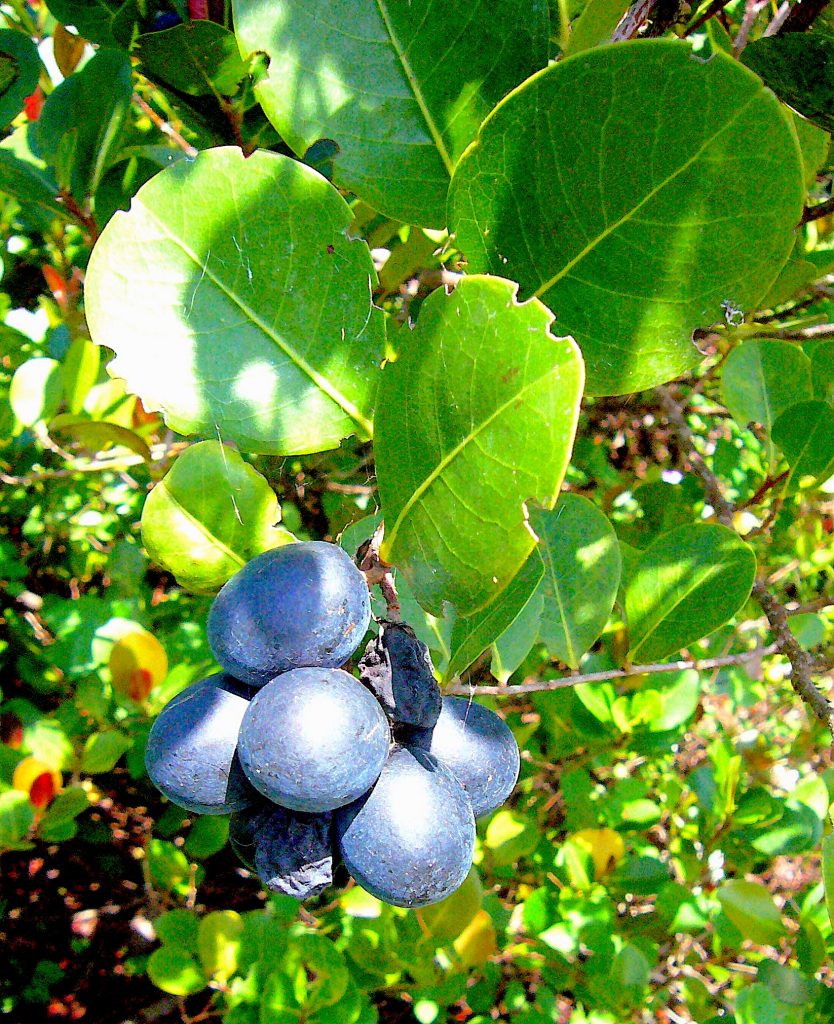
Cocoplums come in three colors but one flavor. Photo by Green Deane
Our foraging class in Port Charlotte this past week was above and beyond if you like fruit. First we found ripe Cocoplums. They are not a true plum but are about the right size to be called that. They come in three colors, red, white and dark blue/purple. We found the purple ones. Cocoplums are not everyone’s favorite but I like them and the seed tastes like granola. Many folks do not like the outer pulp for texture reasons but it all tastes good to me.
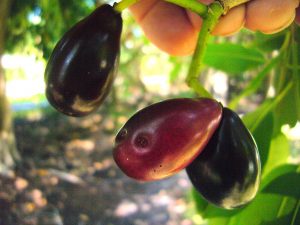
Ripe Jambul fruit is slightly astringent. Photo by Green Deane
Another fruiting star of the day was the Jambul Tree, which like the Cocoplum comes in three colors, white, red and dark purple. It’s a large commercial product in the Asian part of the world. Even when totally ripe and sweet there is a bit of astringency. While there seems to be several fruiting trees in the Port Charlotte and Punta Gorda area, I know of only one in greater Orlando.That’s at the southwest corner of Aragon Avenue and Miles Avenue in Winter Park. I also know they grow in West Palm Beach with three of them just north of the garden center building in Dreher Park. As they are somewhat cold tolerant I am surprised they didn’t become a commercial crop in Florida. Perhaps citrus was king. When mature Jambuls make a large, well-shaped shade tree. We also saw several mango trees dropping ripe fruit. They were all the Mexican cultivar “Champagne Mangoes.” It makes one wonder if the mangos and the Jambul trees were all part of the same riverside property at one time. This is also where the story takes a personal turn. As mangoes are closely related to poison Ivy when I first found these trees I did not know if I had an allergy to mangos or not. Well into my 60’s and I had never actually eaten the fruit. So I brought several home and tried them. No allergy and I like the flavor… too much.
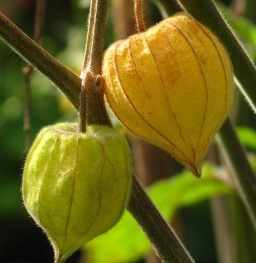
As the Ground Cherry ripens inside the husk turns golden outside.
Also for the finding were Ground Cherries. Like the “plums” mentioned above Ground Cherries are not cherries but more closely related to tomatillos. We found ripe ones in two places so everyone got a chance to taste the fruit. They can produce all year but tend to have two seasons, before and after the summer heat. For many years I could not tell apart two ground cherries, Physalis walteri and Physalis viscosa. Individually they were mentioned in different books. The pictures were different, too, and the descriptions. Then one day I bought a third book and the mystery was solved. It said both species were the same plant. Both previous authors, in their egotistic little ways, failed to mention the plant had a synonym. And while they both described the plant each chose which details to include and how exacting to be. And as it were, the pictures each included showed a yellow flower pointing down. One can guess why: Sometimes the blossom has a ruby throat and sometimes it does not. That was something those two authors failed to mention but the third did along with including the synonyms. Mystery solved. As for the photos looking differently, plants of the same species can look different depending up many things such as daylight conditions or different environmental factors from one location to another. Some mistakes, however, are not so forgivable.

Foraging classes are held rain or shine, heat or cold.
Foraging classes this weekend vary a lot. One is a familiar place, Florida State College in Jacksonville, always productive. We meet by the administration building. Our Sunday class is closer to home, Venetans Gardens in Leesburg, not a location I visit too often. The Leesburgians had a bright idea one day regarding what to do about several low islands on west end of Lake Harris. They added small bridges, fix it up some, and called it Venetian Gardens. We meet in the parking lot near the pool.
Saturday, July 28th, Florida State College, south campus, 11901 Beach Blvd., Jacksonville, 32246. We will meet at building “D” next to the administration parking lot. 9 a.m.
Sunday, July 29th, Venetian Gardens, 201 E. Dixie Ave, Leesburg, FL 34748. 9 a.m. Meet at the parking lot near the pool.
Saturday, August 4th, Blanchard Park, 10501 Jay Blanchard Trail, Orlando, FL 32817. 9 a.m. Meet at the pavilion east of the tennis courts near the YMCA.
Sunday, August 5th, Boulware Springs Park, 3420 SE 15th St., Gainesville, FL 32641. Meet at the picnic tables next to the pump house. 9 a.m.
Saturday, August 11th, Dreher Park, 1200 Southern Blvd., West Palm Beach, 33405. As this is the hot summer time do you want to meet at 8 a.m.? Just north of the science center.
Monday, August 27th, 1624 Taylor Road, Honea Path, South Carolina. Ever want to meet Green Deane but he never seems to come to your neck of the woods? Then mark Monday, August 27th, on your calendar. Green Deane will have a free foraging class in Honea Path, South Carolina, at the Putney Farm, 1624 Taylor Road. The foraging begins at 10 a.m., rain or shine (except hurricanes.) All of Green Deane’s classes are hands on, walking outside. Wild edible plants, medicinals and perhaps a mushroom or two will be on the agenda (as Green Deane is in the Carolinas that week studying local mushrooms.) Donations to Putney Farm are appreciated as they are hosting the event. For more information you can contact Putney Farm on Facebook or Green Deane at GreenDeane@gmail.com.
For more class information or to sign up go here.
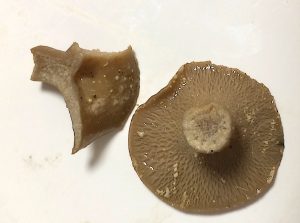
Fermenting the mushrooms turned them from white to gray.
Did some experimenting this past month. Locally we have a couple of mushrooms that are way too peppery to eat. They are both in the Lactifluus genus, L. piperatus and L. glaucscens. Sometimes in foraging you have to go to different cultures to get a different view of a plant species. A plant Americans might call toxic the Spanish might call worth cultivating as a commercial crop. A mushroom the British call “oily” the Russians might call “buttery.” I had read that in places like Russia and Finland et cetera they fermented these peppery mushrooms rendering them edible. So… I lacto-fermented two Lactifluus piperatus (var. piperatus) for a month. And indeed they are no longer peppery. Oddly they are not sour either. They also shrunk about 33% in size and went from white to gray. I tasted them but did not consume. But, for certain, the burning went away. Next step: Ferment some more and perhaps try a tiny bit.
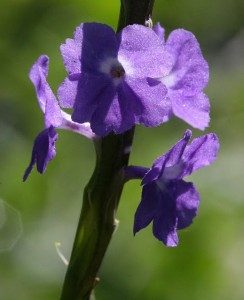
Blue Porterweed blossoms taste like raw mushrooms.
Do you like mushrooms but want to avoid the complexities of fungi foraging? Then there is a subtle solution: Blue Porterweed. Found in flower gardens around the world and native to Florida the Blue Porterweed earned its name as a source for tea that tasted like porter beer. Someone had the fermenting idea to add yeast and sugar to a lot of tea and get a brew that tastes similar to porter beer, hence the name. The flower garden variety usually grows up and the local native grows horizontally. The blue flowers, raw, have a subtle flavor of mushrooms. You can read more about the Blue Porterweed here. Oh, and how did porter beer get its name? The same way porter steak did. Porters — baggage handles in old central London — worked all hours and needed quick food. Shops set up to meet that need and out of them came several dishes and named items.

Green Deane DVD Set
All of Green Deane’s videos available for free on You Tube. They do have ads on them so every time you watch a Green Deane video I get a quarter of one cent. Four views, one cent. Not exactly a large money-maker but it helps pays for this newsletter. If you want to see the videos without ads and some in slightly better quality you can order the DVD set. It is nine DVDs with 15 videos on each. Many people want their own copy of the videos or they have a slow service and its easier to order then to watch them on-line. They make a good gift for that forager you know. Individual DVDs can also be ordered. You can order them by clicking on the button on the top right of this page or you can go here.

Green Deane Forum
Want to identify a plant? Need to identify a plant? Looking for a foraging reference? Maybe you have a UFO, an Unidentified Flowering Object, you want identified. On the Green Deane Forum we — including Green Deane — chat about foraging all year. And it’s not just about warm-weather plants or just North American flora. Many nations share common weeds so there’s a lot to talk about. There’s also more than weeds. The reference section has information for foraging around the world. There are articles on food preservation, and forgotten skills from making bows to fermenting food. Topics have included: Tea, Salt and Amla, Small Bush and Flower, Ragweed? Pine Cough Drops and Needles, Odd Vine? Hunting and Trapping Ethics. Knife Accidents. Some Kind of Lespendeza and Survival Garden. You can join the forum by clicking on the button in the menu line.
This is weekly issue 314.
If you would like to donate to Eat The Weeds please click here. Or you can use my Go Fund Me link, or by writing to Green Deane POB 941793 Maitland FL, 32794.
Food is where the water is
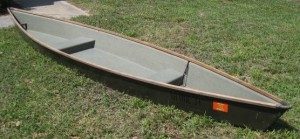
My 13-foot, 55-pound pirogue.
It makes no difference whether that water is fresh or salt. The flora and fauna will change but food is where the water is. How to get on that water is a different issue. Getting wet while getting food is not a huge issue in the good ol’ summer time. It’s another matter in chilblain winter. Kayaks are light and maneuverable but can’t carry much and don’t lend themselves to leaning for that choice plant. A small canoe is good but can be tippy, and a big canoe, while stable, can be heavy. This is said with some experience. I have a 12-foot kayak and an 18-foot canoe. Catch a big fish in the kayak and it’s in your lap. What little storage space there is for wild edibles is a rocky twist behind you in the stern. My huge canoe is great for a month in the wilderness and can hold a lot of cargo. But it is hard to navigate in small places and at 85 pounds it’s a bit for one man to portage to and fro. Lately I’ve been trying out a pirogue (said PEE-row or PEE-rog.) Pirogues are Cajun flat-bottom canoes with angled, low sides. Small, stable, easy to maneuver, and light they also have a shallow draft. They are inexpensive, far less than canoes or kayaks. Pirogues are for ponds, slow streams, and shallow marshes, exactly where a forager and some fishermen go. The one on the left is rated for two adults but they had better weight no more than 150 pounds apiece. This particular pirogue easily holds the paddler, a cooler, tackle box and a dog in front. Green Deane is raiding local lakes with it.


I know Ground Cherries in Kordofan- Western Sudan – there locally called ” Cucco Tomato ” .There , nowadays it is raining heavily . Also it is rainy season and Monsoon winds almost through out whole Sudan. Here in my garden and outside my house I can witness many of the plants ; some starting fruiting .
Sorry,I’ve forgotten to mention that “Cucco” is vernacular for “monkey” .Moreover, the people in that part of Sudan eat the ripe ground cherry. I like other names e.g. Chinese lantern .
The pirogue looks like a good canoe a for a man and his dog.